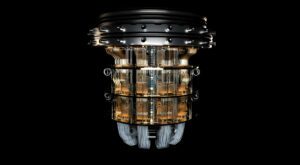The French Revolution (1789-94) and the Napoleon Wars that followed it, affected the arts as well as politics. The “classical” arts of the 18th century, though not unromantic, obeyed certain rules. “Romantics” regarded these as less important than vivid colours and vitality. The leading French Romantic was Eugène Delacroix, born in 1798. A frail, lonely child, he first showed talent at his Bordeaux school for the violin.
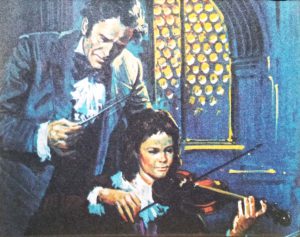 Pin
Pin 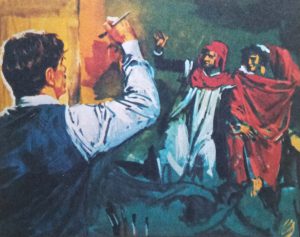 Pin
Pin In Paris he met an older boy named Géricault, who was also destined to be a major artist. Both were taught by a well-known painter, Baron Guérin. The young Delacroix, his head full of music, poetry and the splendours of architecture, and impressed by his friend’s talents, became more and more attracted to painting. Aged 23, he painted ‘‘Dante and Virgil crossing the Styx”, hoping to have it accepted by the important Paris Salon Exhibition.
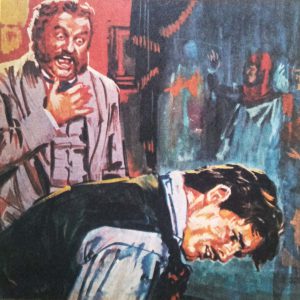 Pin
Pin His teacher was appalled when he saw it. “No one has ever painted like that!’’ he cried. “All those lurid blues and greens and that hideous flesh colour. You cannot send such a monstrosity to the Salon. You will be the laughing stock of Paris and shall be mocked for having produced such a pupil.’’ Poor Delacroix had broken the rules! But he sent the picture in, nonetheless, and it caused a sensation. Its vivid colours thrilled viewers and Delacroix was famous.
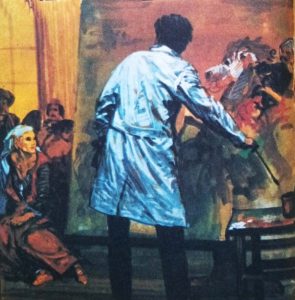 Pin
Pin The picture was bought by the French nation and, despite crippling bouts of fever, Delacroix started on other subjects. He loved the colourful stories of the Orient and its landscapes and chose an exciting theme, “The Massacre at Scio”. It was a big subject and required many professional models and friends to pose for it. After many months work he was satisfied and sent it to the Paris Salon. It was given a place of honour.
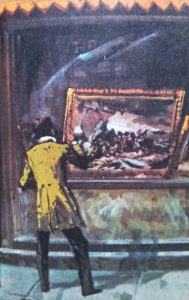 Pin
Pin Just four days before the opening in 1824, he saw a painting by his friend Géricault, who had tragically died as a result of a fall from a horse. The brilliant colours and the life in the picture, which he saw in the window of a dealer, inspired him. So did a glimpse of the English artist John Constable’s great picture “The Hay Wain”, which was in the Salon. With just four days to go before the official opening of the Salon, he began repainting his work! It was an astonishing risk to take.
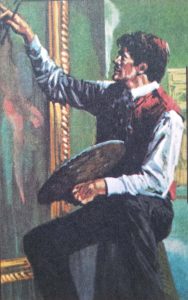 Pin
Pin The Paris Salon authorities agreed to the startling request by the young artist to remove his painting. Then by day and night he laboured frantically to improve the picture, adding spots of bright colour all over the canvas so that the scene seemed bathed in light. The paint was still fresh and wet when the exhibition opened. It caused a sensation, and was attacked by some critics for its daring. But the French State had no doubts about it and bought it for a record price of 5000 francs.
 Pin
Pin At the suggestion of an English friend and artist, Richard Bonnington, he visited Britain. He loved London and discovered Shakespeare, who with Sir Walter Scott and Lord Byron, was to be the source of many of his inspirations. North Africa, too, was to provide him with many subjects. He had by now become the major painter of the French Romantic Movement and it was greatly to the credit of the authorities that they recognised that they had a genius working in their midst.
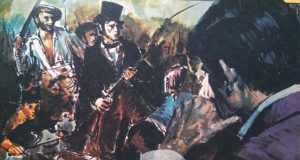 Pin
Pin Revolution was again in the air, and one July day in 1830, when Delacroix was out walking, he saw a crowd marching behind the French flag. In his mind’s eye he saw Liberty guiding the people against tyranny. He returned to his studio and painted a masterpiece. Because Revolution was its subject, it was not known for many years, but now it has a place of honour in the Louvre in Paris.
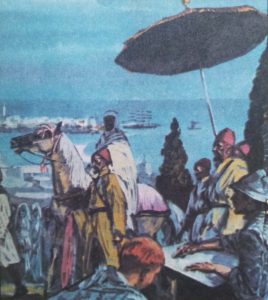 Pin
Pin In 1832, Delacroix was chosen to accompany the Count de Mornay on a goodwill mission to the Sultan of Morocco. This was the key moment when he fell under the spell of the East which was to inspire him for the rest of his life. From the moment his ship sailed into Tangier harbour he was overcome by its magic — the hot sun on colourful buildings, the graceful Arab women, the fierce warriors on their chargers: all were to inspire him.
 Pin
Pin Everywhere he went to draw, drawings that he would later use as the basis of paintings. He and his party came at last to Meknes and the palace of the Sultan Muley-Abd-El-Rahmann, who rode out of his gate to meet his visitors. Delacroix drew the colourful scene, resting his sketch-book on his pommel. Later, he turned the scene into one of his finest paintings.
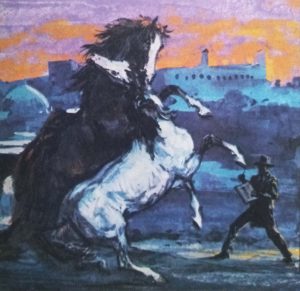 Pin
Pin The Sultan was so impressed by Delacroix that he broke the rules and allowed the artist into his harem to draw his many wives! One day, beyond the city walls, Delacroix watched a fight between wild stallions. Heedless of the fearful risk he was taking, he got as close as possible to sketch the dramatic scene, as unshod hooves lashed the air only a few feet from where he stood. Naturally, this thrilling episode led to his painting another great work of art, which today can be seen in the Louvre.
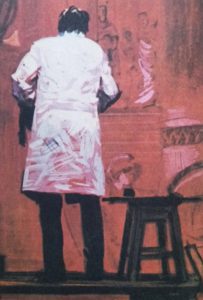 Pin
Pin Delacroix’s eastern paintings made him more famous than ever, and for the rest of his life he never lacked work. He painted vast wall decorations in churches and public buildings. The finest of these — a huge picture called “Helidorus being driven from the Temple” — can be seen in the Church of St. Sulpice. Yet he did many delightful small subjects as well. Venerated by younger artists, he died in 1863.
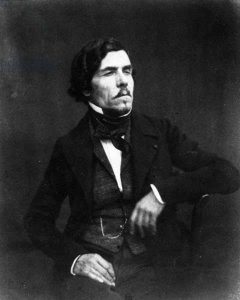 Pin
Pin Ferdinand Victor Eugène Delacroix was a French Romantic artist who is considered one of the greatest painters of the 19th century. He was born on April 26, 1798, in Charenton-Saint-Maurice, a suburb of Paris, France. Delacroix’s father, Charles-François Delacroix, was a diplomat, and his mother, Victoire Oeben, was the daughter of a famous cabinetmaker.
Delacroix showed an interest in art from an early age and received his first artistic training from Pierre-Narcisse Guérin, a neoclassical painter. He later studied at the École des Beaux-Arts in Paris, where he became acquainted with prominent artists such as Théodore Géricault and Jean-Auguste-Dominique Ingres. Despite these influences, Delacroix developed his own distinctive style, which was characterized by its vibrant colors, dramatic compositions, and emotive brushwork.
One of Delacroix’s early notable works is “The Barque of Dante” (1822), which depicts Dante Alighieri’s journey through hell, as described in his epic poem, “The Divine Comedy.” The painting showcases Delacroix’s skill in capturing intense emotions, with its tumultuous waves, tortured figures, and vivid color palette. This work established him as a leading figure in the emerging Romantic movement in art.
Delacroix’s choice of subject matter often revolved around historical and literary themes, which allowed him to explore his fascination with exoticism, violence, and sensuality. Some of his most famous works include “Liberty Leading the People” (1830), inspired by the July Revolution of the same year, and “The Death of Sardanapalus” (1827), based on Lord Byron’s play.
“Liberty Leading the People” is an iconic painting that epitomizes Delacroix’s ability to capture the spirit of revolution. It depicts a triumphant female allegorical figure leading a diverse group of revolutionaries over the barricades in Paris. The painting’s composition, dynamic brushwork, and rich colors convey the energy and excitement of the revolutionary moment.
In “The Death of Sardanapalus,” Delacroix depicts the ancient Assyrian king during his final moments, surrounded by his treasures, concubines, and loyal servants. The scene is filled with chaos and violence, with figures engaged in passionate acts of self-sacrifice, murder, and debauchery. The painting’s intense emotional impact and its exploration of decadence and excess showcase Delacroix’s interest in exploring the human psyche and its darker aspects.
Delacroix’s artistry went beyond painting, as he was also an accomplished draftsman and lithographer. His sketches and studies show his keen observation of human anatomy and movement, and his lithographs allowed him to reach a wider audience, disseminating his artistic ideas and themes.
Throughout his career, Delacroix received numerous honors and recognition for his contributions to the arts. He became a member of the Académie des Beaux-Arts in 1857 and received the Legion of Honor in 1831. Today, his works are exhibited in major museums worldwide, including the Louvre in Paris, the Metropolitan Museum of Art in New York, and the National Gallery in London.
Eugène Delacroix died on August 13, 1863, at the age of 65, leaving behind an extensive body of work that continues to inspire and influence generations of artists. His exploration of emotion, individualism, and humanity’s relationship with the forces of nature and society remains relevant and captivating to this day. Delacroix’s legacy as a leading figure of the Romantic movement and his mastery of color and technique make him an enduring icon in the history of art.
Some Artworks by Delacroix:
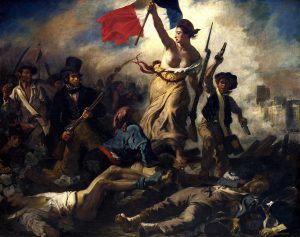 Pin
Pin  Pin
Pin 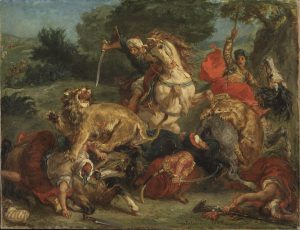 Pin
Pin 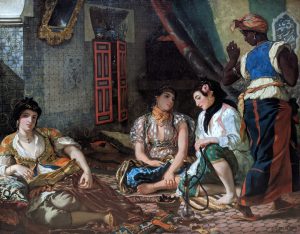 Pin
Pin  Pin
Pin 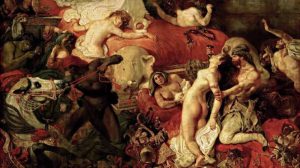 Pin
Pin 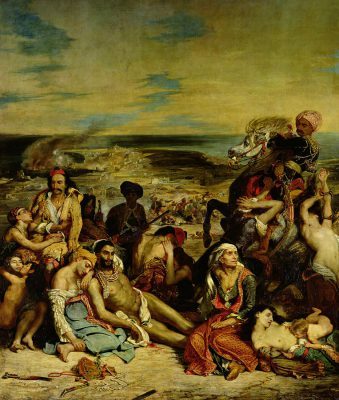 Pin
Pin The major themes in Eugène Delacroix's artwork revolve around historical and literary subjects, exoticism, and the exploration of human emotions. His influences include Greek and Roman art, the works of Old Masters like Peter Paul Rubens and Michelangelo, as well as the writings of Lord Byron and William Shakespeare. These themes and influences contributed to his status as a leading figure in the Romantic movement in several ways.
Emotion and Individual Expression
Copied
Emotion and Individual Expression
Delacroix's artwork was characterized by vivid and passionate depictions of emotion. He sought to capture the intensity and drama of human experiences, often exploring themes of love, suffering, and tragedy. Delacroix's ability to convey deep emotions through his brushstrokes and use of color resonated with the Romantic spirit, which celebrated the individual's expression of emotion and rejected the rational and intellectual in favor of the subjective.
Delacroix's artwork was characterized by vivid and passionate depictions of emotion. He sought to capture the intensity and drama of human experiences, often exploring themes of love, suffering, and tragedy. Delacroix's ability to convey deep emotions through his brushstrokes and use of color resonated with the Romantic spirit, which celebrated the individual's expression of emotion and rejected the rational and intellectual in favor of the subjective.
Delacroix’s artwork was characterized by vivid and passionate depictions of emotion. He sought to capture the intensity and drama of human experiences, often exploring themes of love, suffering, and tragedy. Delacroix’s ability to convey deep emotions through his brushstrokes and use of color resonated with the Romantic spirit, which celebrated the individual’s expression of emotion and rejected the rational and intellectual in favor of the subjective.
Historical and Literary Subjects
Copied
Historical and Literary Subjects
Delacroix frequently drew inspiration from history, mythology, and literature. He depicted scenes from classical mythology, biblical stories, and historical events. His choice of these subjects aligned with the Romantic interest in the past as a source of inspiration and the exploration of grand narratives. By reimagining these narratives through his own perspective, Delacroix infused his art with a sense of passion and personal interpretation that resonated with Romantic ideals.
Delacroix frequently drew inspiration from history, mythology, and literature. He depicted scenes from classical mythology, biblical stories, and historical events. His choice of these subjects aligned with the Romantic interest in the past as a source of inspiration and the exploration of grand narratives. By reimagining these narratives through his own perspective, Delacroix infused his art with a sense of passion and personal interpretation that resonated with Romantic ideals.
Delacroix frequently drew inspiration from history, mythology, and literature. He depicted scenes from classical mythology, biblical stories, and historical events. His choice of these subjects aligned with the Romantic interest in the past as a source of inspiration and the exploration of grand narratives. By reimagining these narratives through his own perspective, Delacroix infused his art with a sense of passion and personal interpretation that resonated with Romantic ideals.
Exoticism and Orientalism
Copied
Exoticism and Orientalism
Delacroix's fascination with the exotic and the Orient was another important theme in his artwork. Inspired by his travels to North Africa and the Middle East, he created numerous paintings depicting scenes of harems, North African landscapes, and Arab horsemen. These works, often filled with vibrant colors and intricate details, appealed to the Romantic fascination with the unknown, the exotic, and the mysterious. They offered an escape from the familiar and reflected the Romantic yearning for the distant and the unconventional.
Delacroix's fascination with the exotic and the Orient was another important theme in his artwork. Inspired by his travels to North Africa and the Middle East, he created numerous paintings depicting scenes of harems, North African landscapes, and Arab horsemen. These works, often filled with vibrant colors and intricate details, appealed to the Romantic fascination with the unknown, the exotic, and the mysterious. They offered an escape from the familiar and reflected the Romantic yearning for the distant and the unconventional.
Delacroix’s fascination with the exotic and the Orient was another important theme in his artwork. Inspired by his travels to North Africa and the Middle East, he created numerous paintings depicting scenes of harems, North African landscapes, and Arab horsemen. These works, often filled with vibrant colors and intricate details, appealed to the Romantic fascination with the unknown, the exotic, and the mysterious. They offered an escape from the familiar and reflected the Romantic yearning for the distant and the unconventional.
Dynamic Technique and Use of Color
Copied
Dynamic Technique and Use of Color
Delacroix's distinctive technique, characterized by loose brushwork and vibrant colors, greatly contributed to his status as a leading figure in the Romantic movement. He broke away from the neoclassical tradition of smooth, polished surfaces and emphasized the painterly qualities of his artwork. His bold and expressive use of color, often with contrasting hues, added to the emotional impact of his paintings. This departure from traditional academic conventions attracted attention and admiration, making Delacroix a central figure in the Romantic movement's rejection of traditional norms.
Delacroix's distinctive technique, characterized by loose brushwork and vibrant colors, greatly contributed to his status as a leading figure in the Romantic movement. He broke away from the neoclassical tradition of smooth, polished surfaces and emphasized the painterly qualities of his artwork. His bold and expressive use of color, often with contrasting hues, added to the emotional impact of his paintings. This departure from traditional academic conventions attracted attention and admiration, making Delacroix a central figure in the Romantic movement's rejection of traditional norms.
Delacroix’s distinctive technique, characterized by loose brushwork and vibrant colors, greatly contributed to his status as a leading figure in the Romantic movement. He broke away from the neoclassical tradition of smooth, polished surfaces and emphasized the painterly qualities of his artwork. His bold and expressive use of color, often with contrasting hues, added to the emotional impact of his paintings. This departure from traditional academic conventions attracted attention and admiration, making Delacroix a central figure in the Romantic movement’s rejection of traditional norms.
Eugène Delacroix’s major themes and influences, including the exploration of emotions, historical and literary subjects, exoticism, and his dynamic technique, contributed to his status as a leading figure in the Romantic movement. His art captured the spirit of Romanticism by celebrating individual expression, exploring the power of emotions, and defying traditional artistic conventions. Delacroix’s works continue to be recognized as emblematic of the Romantic movement’s embrace of freedom, subjectivity, and heightened emotions.
Delacroix's travels, particularly his visits to North Africa and the Middle East, had a profound impact on his art and played a significant role in shaping his artistic style and subject matter. Here are some ways in which these travels inspired and influenced his work:
-
Exoticism and Orientalism
CopiedExoticism and OrientalismDelacroix was fascinated by the vibrant colors, striking landscapes, and exotic cultures he encountered in North Africa and the Middle East. The experience of these foreign lands deeply influenced his artistic style, as he integrated elements of Orientalism into his works. Orientalism refers to a fascination and idealization of the East, portraying it as mysterious and exotic. Delacroix's paintings often featured subjects and scenes from these regions, evoking a sense of exoticism through his use of rich colors, detailed patterns, and ornate architecture.
Delacroix was fascinated by the vibrant colors, striking landscapes, and exotic cultures he encountered in North Africa and the Middle East. The experience of these foreign lands deeply influenced his artistic style, as he integrated elements of Orientalism into his works. Orientalism refers to a fascination and idealization of the East, portraying it as mysterious and exotic. Delacroix’s paintings often featured subjects and scenes from these regions, evoking a sense of exoticism through his use of rich colors, detailed patterns, and ornate architecture.
-
Exploration of Light and Color
CopiedExploration of Light and ColorThe intense sunlight and vivid hues of North Africa and the Middle East had a profound impact on Delacroix's exploration of color and light in his paintings. He was inspired by the way light interacted with the landscapes, architecture, and people, and sought to capture the brilliant and luminous qualities of the Orient in his art. Delacroix experimented with bold, contrasting colors, using strong brushstrokes and a vibrant palette to convey the intensity and brilliance of the region's light.
The intense sunlight and vivid hues of North Africa and the Middle East had a profound impact on Delacroix’s exploration of color and light in his paintings. He was inspired by the way light interacted with the landscapes, architecture, and people, and sought to capture the brilliant and luminous qualities of the Orient in his art. Delacroix experimented with bold, contrasting colors, using strong brushstrokes and a vibrant palette to convey the intensity and brilliance of the region’s light.
-
Romanticism and Emotional Expression
CopiedRomanticism and Emotional ExpressionDelacroix's travels also deepened his connection to the Romantic movement, which emphasized the expression of intense emotions and subjective experiences. In North Africa and the Middle East, he witnessed scenes of war, turbulent political events, and vibrant street life, which evoked strong emotions in him. His experiences fueled his desire to create emotionally charged works that portrayed both the grandeur and the turmoil of the human condition. Delacroix used dramatic compositions, dynamic brushwork, and intense expressions to convey a sense of energy, passion, and emotional depth in his paintings.
Delacroix’s travels also deepened his connection to the Romantic movement, which emphasized the expression of intense emotions and subjective experiences. In North Africa and the Middle East, he witnessed scenes of war, turbulent political events, and vibrant street life, which evoked strong emotions in him. His experiences fueled his desire to create emotionally charged works that portrayed both the grandeur and the turmoil of the human condition. Delacroix used dramatic compositions, dynamic brushwork, and intense expressions to convey a sense of energy, passion, and emotional depth in his paintings.
-
Influence on French Academic Art
CopiedInfluence on French Academic ArtDelacroix's travels and his incorporation of Orientalist themes and techniques had a transformative effect on the French academic art scene. He challenged the traditional standards and conventions of the Académie des Beaux-Arts by introducing a more personal and expressive approach to his work. Delacroix's use of vibrant colors, loose brushwork, and unconventional compositions brought a new level of dynamism and individuality to academic art, influencing subsequent generations of artists and paving the way for artistic movements such as Impressionism.
Delacroix’s travels and his incorporation of Orientalist themes and techniques had a transformative effect on the French academic art scene. He challenged the traditional standards and conventions of the Académie des Beaux-Arts by introducing a more personal and expressive approach to his work. Delacroix’s use of vibrant colors, loose brushwork, and unconventional compositions brought a new level of dynamism and individuality to academic art, influencing subsequent generations of artists and paving the way for artistic movements such as Impressionism.
Delacroix’s travels to North Africa and the Middle East sparked his fascination with exoticism, inspired his exploration of light and color, deepened his connection to the Romantic movement, and influenced the development of French academic art. These experiences shaped the content, style, and emotional intensity of his paintings, leaving a lasting impact on the art world.
Eugène Delacroix, a 19th-century French painter, was one of the leading figures of the Romantic movement. His works reflected his passion, vivid colors, and dynamic brushstrokes, challenging the previous art conventions. Here are some of his most famous paintings and their significance in art history:
- 1. “Liberty Leading the People” (1830): This painting is an iconic representation of the July Revolution of 1830 in France. Delacroix portrays Liberty as a female figure leading a group of people from all walks of life, holding the tricolor flag. The painting’s significance lies in its powerful symbolism and portrayal of the spirit of revolution, highlighting the desire for freedom and the fight against oppression.
- 2. “The Death of Sardanapalus” (1827): Based on a tragic tale from Assyrian history, this painting captured intense drama and emotional turmoil. Delacroix’s use of rich colors and expressive brushwork showcases his ability to create a sense of chaos and passion. “The Death of Sardanapalus” was controversial for its explicit violence and eroticism, challenging the prevailing norms of art at the time.
- 3. “The Women of Algiers in Their Apartment” (1834): This painting was inspired by Delacroix’s visit to North Africa, which was seen as exotic in the European imagination. With vibrant colors and intricate details, Delacroix depicted a harem scene, showcasing sensuality and Orientalist imagery. The artwork was influential in shaping the Orientalist movement, which romanticized the East and increased interest in other cultures.
- 4. “The Massacre at Chios” (1824): This painting was created in response to the Greek Revolution against the Ottoman Empire. Delacroix portrayed the brutality and suffering of war by depicting a devastated landscape and its inhabitants. “The Massacre at Chios” sparked debates about the role of art in addressing political and humanitarian issues, solidifying Delacroix’s reputation as a socially engaged painter.
- 5. “The Barque of Dante” (1822): Inspired by Dante Alighieri’s “Divine Comedy,” this painting depicts the poet’s exploration of hell. Delacroix’s interpretation emphasizes the dramatic and tormented atmosphere of the inferno, reflecting the Romantic fascination with dark and mysterious themes. “The Barque of Dante” contributed to the revival of interest in Dante’s work and the Romantic trend of exploring the human psyche.
These paintings by Delacroix, with their emotional intensity, bold use of color, and innovative techniques, were highly significant in the development of Romanticism and the progressive art movements that followed. They challenged traditional rules and inspired future generations of artists to express their own emotions and explore new artistic possibilities.
Frequently Asked Questions: Ferdinand Victor Eugène Delacroix
Eugène Delacroix was a French painter born on April 26, 1798, in Charenton-Saint-Maurice, France. He is considered one of the most influential artists of the 19th century and played a significant role in the Romantic art movement. Delacroix is known for his dramatic and emotionally charged paintings, depicting historical events, literature, mythology, and exotic subjects. His works are characterized by vibrant colors, energetic brushwork, and a sense of movement.
Delacroix’s most famous works include “Liberty Leading the People,” “The Death of Sardanapalus,” “The Women of Algiers,” “The Barque of Dante,” and “The Massacre at Chios.” These paintings showcase his mastery of color and ability to convey intense emotions.
“Liberty Leading the People” is one of Delacroix’s most iconic works and portrays the July Revolution of 1830 in Paris. It shows a powerful allegorical figure representing Liberty leading a diverse group of people in their fight for freedom. This painting symbolizes the democratic ideals and the triumph of liberty over tyranny. It became an enduring symbol of the French Republic and inspired future generations of activists and revolutionaries.
Delacroix believed in the importance of direct observation and sketched extensively from life. He would study the anatomy of humans and animals to accurately portray their movements and emotions in his paintings. His artistic style combined academic training with a passion for color and expression, often deviating from the traditional rules of composition and perspective.
Delacroix was a key figure in the Romantic art movement, which emerged in the late 18th century as a response to the Industrial Revolution and the Enlightenment era. Romantic artists sought to evoke powerful emotions, embrace individualism, and depict the sublime and fantastical through their works. Delacroix’s use of vibrant colors, lively brushwork, and dramatic subjects aligned him with the principles of the Romantic movement.
Yes, Delacroix traveled extensively throughout his life, taking inspiration from various cultures and landscapes. He journeyed to North Africa (Morocco, Algeria), where he was captivated by the vibrant colors, architecture, and exoticism of the region. These experiences had a significant impact on his artistic style and subject matter, infusing his works with a sense of the exotic and unfamiliar.
Delacroix believed that art had the power to convey political and social messages. His paintings often carry a strong sense of social commentary, depicting scenes of revolution, war, and injustice. He saw himself as an advocate for freedom and justice, using his artistic platform to raise awareness and incite change. Delacroix’s paintings expressed his personal viewpoints while capturing the broader socio-political climate of his time.
Yes, Delacroix gained recognition and achieved success during his lifetime. He exhibited his works at the Paris Salon, the prestigious art exhibition of the time, and received numerous commissions from prominent figures and institutions. His paintings were highly influential, inspiring a new generation of artists. Delacroix’s impact on the art world continues to be celebrated even today.
Delacroix’s legacy lies in his innovative approach to painting, his emotional intensity, and his use of color. His works bridged the gap between the Neoclassical and Romantic movements, influencing artists such as Vincent van Gogh and Henri Matisse. Delacroix’s contributions to the art world and his commitment to artistic freedom and expression have solidified his place as one of the greatest painters in history.
Eugène Delacroix’s works can be found in various museums around the world, including the Louvre Museum in Paris, the Metropolitan Museum of Art in New York, the National Gallery in London, and the Musée du Louvre Abu Dhabi. These institutions often display his masterpieces, providing an opportunity for art enthusiasts to appreciate his artistic genius.



























